
MAY CONTAIN NUTS

Search Shorpy
SHORPY ART

Framed or unframed, desk size to sofa size, printed by us in Arizona and Alabama since 2007. Explore now.
Join and Share
Ad-Free Shorpy
Shorpy is funded by you. Patreon contributors get an ad-free experience.
Learn more.

Recent comments
- Recent view
- Hudson’s Big Store
- Say what??
- Grapes?!
- A Beautiful Moment
- Such joy
- Bethune-Cookman University today...
- Yellow sky at morning
- Side Winder
- Air Quality?
- Sojourner Truth riot
- None were so blind(ed)
- The less famous sister
- Good ol' days?
- Rise and Fall
- Goo Goo Ga Joob
- Ticket Retention
- Not the only one
- Vagaries of War
- Killed by Amtrak
- Back to the Future
- Wanted --
- If you can't stand the light
- Centralized Traffic Control, I believe
- What's really happening
- Heckuva remote control!
- Sometimes — Things Go Bump!
- I SEE THE LIGHT
- Union Switch and Signal Company
- Get That Light Out Of My Eyes
Member Photos
The Shorpy
Print Emporium
Print Emporium
Search Shorpy
Search results -- 30 results per page
- Klassy Kamp: 1914
- ... Victrola and waterborne equivalent of a Coke machine. The Arlington Bottling sign on the boat advertises "Ginger Ale, Sarsaparilla, Lemon ... Posted by Dave - 07/12/2014 - 2:59pm -
![Klassy Kamp: 1914 Washington, D.C. (vicinity), 1914. "Summer camps on the Potomac. Klassy Kamp." I think there's probably enough going on in this one picture for a 10-part Ken Burns documentary. Note the Victrola and waterborne equivalent of a Coke machine. The Arlington Bottling sign on the boat advertises "Ginger Ale, Sarsaparilla, Lemon Soda." National Photo glass negative. View full size.
Mixed MediaAmerican flags, Japanese paper lanterns, today's newspaper, and an iPod a Victrola -- Not just Klassy, but Kosmopolitan!
Evening Music
Washington Post, Aug 29, 1915
Society
"Klassy Kamp" on the Potomac was the scene of a pleasant entertainment last Sunday evening, many guests being from Washington and from other camps on the river. The music was the feature of the evening. Messrs. Winnie, Lester, Dudley, Lawrence, Reynolds, Powell and Grimm played guitars and mandolins, after which Messrs, Harry Gillman and Donald Libbey rendered several Hawaiian selections. Supper was served before midnight.
BottlesSeveral of the rustic fenceposts have an empty bottle in front of them ... has anyone any idea of the purpose or significance of these carefully positioned bottles?
[Decorations. - Dave]
Summer eveningsAnything to escape the heat of the city in summer.
That these people were willing to brave the giant mosquitoes of the tidal flats, some as large as pheasants, is a testament to the stifling heat in the days before air-conditioning.
We slept on the porch when I was a kid, and that was in the 60's.
More kool kampsPotomac river camps in 1917. Note the fanciful names. Click image for more.
Re: Summer eveningsThis wouldn't be the tidal Potomac. It looks to be the west bank on the Virginia side where the GW Parkway is now, and upriver from the Aqueduct Bridge.
Mabel W.I've never seen a canoe important enough to garner a name before. I hope Mabel felt honored.
How to spot someone not of our eraThe man in the chaise longue exhibits one of the differences between people now and then: wearing lace-up leather shoes in a casual outdoor setting. No canvas kicks in Kamp Klassy.
Wildlife
How Wonderful!Notice the man in the far back, center... the one with the sailor's cap and in all white. He is so dashing! What a Beautiful picture!
Alternate PerspectiveWell, I just can't get my head around this being on the West bank. Correct me if I'm wrong, but to me it seems we're looking at Rosslyn and Georgetown from the shores of what is now Roosevelt Island. Back then, long after the Mason family abandoned the island, it was used by various groups as a recreational site. Seems possible to me that this was an excursion by the Analstan Boat Club, or something of that ilk. Love the shot! I was born in Georgetown, (when Georgetown was the "slums") and I truly enjoy the looks back to a calmer, saner time.
[These camps were on the Virginia shore of the Potomac. - Dave]
The Newspaper is from June 28, 1914The Sunday Magazine from the Baltimore Sun for June 28th, 1914. With the image entitled "The Tenderfoot" by W. Herbert on the front. Our couple is choosing from one of several titillating articles from that day, such as "Learning A-B-C's at Seventy", "The Woman Who Found Happiness", "Blowing Yourself", "Rozzy, Christmas Angel", "Famous American Duels", and "The Bonehead's Baedeker". And closing out the back page, Canthrox!
Looking at the papers strewn on the groundThe paper the couple bought was actually the Washington Evening Star of June 28, 1914. (The "Sunday Magazine" insert was also in the Baltimore Sun). The image of the woman on the section below their feet is the newly engaged Miss Mary Morris McCauley (to Lt Herbert S. Howard, USN) , and the male image on the paper on the right is an ad from the M. Stein & Co half-price, summer clearance clothing sale at 8th and F streets!
(The Gallery, Camping, D.C., Natl Photo, Sports)](https://www.shorpy.com/files/images/31328u1.thumbnail.jpg)
- Our Man in Havana: 1938
- ... Batista, Cuba's Dictator, as they chatted informally at Arlington while waiting for the arrival of President Roosevelt for the ... Posted by Dave - 08/28/2012 - 1:03pm -
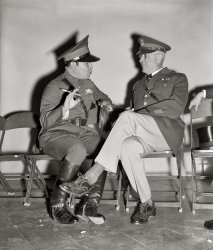
- Auto-Railer: 1935
- ... Dominion obtained one of the Evan units from the defunct Arlington and Fairfax and converted it to a maintenance vehicle.
... Job That Washington, D.C. job may have been on the Arlington & Fairfax trolley line, which replaced its electric cars with ... Posted by Dave - 05/28/2014 - 7:29am -
![Auto-Railer: 1935 ANNAPOLIS, Md., June 26, 1935 (AP) -- Negotiations have been started by the Evans Products Co. of Detroit for the purchase of the Washington, Baltimore & Annapolis Railway, which was recently sold at auction here. The company manufactures buses and trucks that operate either on rails or on the highway, and it is understood the concern plans to operate 100 passenger and freight units between Washington, Baltimore and Annapolis. ... The "auto railer" consists of front and rear steel pilot railroad wheels attached to a conventional type of bus or truck. The pilot wheels are raised for operation over highways but can be let down when the vehicle reaches the tracks. The vehicle runs on its own tires over the rails with the pilot wheels guiding it along the track.
1935. Washington, D.C., or vicinity. "Streamline Bus and Car, Evans Motor." Harris & Ewing Collection glass negative. View full size.
Are any extant?If so, what a novel and attractive project for a guest house/lake/mountain house conversion.
Let me beYou can stand there all day and have your picture taken, for all I care, but this headlight is really something interesting.
SafetyPresumably you can retract the wheels and drive off the tracks when a real train comes along too.
Washington and Old DominionThe Washington and Old Dominion obtained one of the Evan units from the defunct Arlington and Fairfax and converted it to a maintenance vehicle.
Kickin' the TiresSir, I advise you NOT to kick THAT tire.
Evans Auto-railer in actionI recalled seeing an old clip of this machine in action, and here it is. I believe that the scenes were taken along the Grand Trunk Western Jackson Subdivision which ran from Pontiac to Jackson, MI. The branch was abandoned in 1975.
1935 fashionBroad lapels, rolled up trousers, hats and no belly fat!
[Those are real cuffs. -tterrace]
Not a Bump in a CarloadFairmont Railway Motors (now Harsco Rail) is often given credit for coming up with the road-rail technology that created "hi-railers" (they spell it "HY-RAIL") in the 1940s, but the various versions of the Evans product had already been in production for years. The car-like one below was known as the M2.
Their largest Auto-Railer (below) was only one of over a dozen diverse products they made for the war effort during WWII.
Modern TravelerEveryone has done such a good job on the history of auto-railer that I am left to guess at the signage behind the gentlemen. TRIAL “Modern Traveler” ROAD RAIL COACH BODY? Love the Art Deco font.
[SUPERIOR "Modern Traveler." Also: CHEVROLET CHASSIS, TIMKEN AXLES / GOODRICH & UNITED STATES TIRES. The "Modern Traveler" was a streamlined bus body made by Superior Motor Coach Co. of Lima, Ohio. - Dave]
C-Span connectionEvans Products was founded by John Steptoe Evans, whose grandson John D. Evans was a co-founder of C-Span.
Evans Products started out building wood products; first, a wooden block that allowed easy loading of autos on railcars, then cedar separators for the plates in a car battery. John S. Evans set a record in 1928 by flying around the world in 28 days.
Gramps' good jobI knew my grandfather worked for a company called Evans so I emailed my dad this link. here was his reply:
"Yes, this is the same Evans Products. More than that, your grandpa spent a couple of his years at that time driving one of these for the Company when we lived in Detroit. He would be gone for weeks at a time. First, he worked in a small city, Paris, Illinois, and later was transferred to Washington, DC. It always sounded like a good idea to me. It was equipped with both railway wheels and rubber tires, with a mechanism to lower the rubber tires or raise the railway wheels, so they could use the seldom-used rail lines like street-car tracks. Of course the rail lines fought them and tried to scare the public about potential collisions. In the end, the politicians voted against it ... but your grandpa was part of it."
Alas, he's not in the photo, but what a pleasure to see a glimpse of his world. Thanks, Shorpy!
Gramps' JobThat Washington, D.C. job may have been on the Arlington & Fairfax trolley line, which replaced its electric cars with Evans Autorailers. I think they wanted to drive them across the Potomic River without using the D.C. streetcar tracks. One of those later wound up on the Chicago, South Shore & South Bend RR in 1955, with a platform on the roof for working on the overhead wires in East Chicago, Ind.
(The Gallery, Cars, Trucks, Buses, D.C., Harris + Ewing, Railroads)](https://www.shorpy.com/files/images/SHORPY-39036a.thumbnail.jpg)
- Four Belles: 1923
- ... appears in any of these photos.
The shots marked as "Arlington Beach" (e.g. this one ) were taken on the Virginia side of the ... altered all through this period and through WW II. Arlington Beach was an amusement park that sat adjacent to the old Hoover ... Posted by Dave - 09/03/2012 - 10:43am -
![Four Belles: 1923 May 23, 1923. Washington, D.C. "Shrine relay team at Potomac bathing beach." View full size. National Photo Company Collection glass negative.
Tidal BasinWith what appears to be the Bureau of Engraving and Printing Building in the background, this photo locates the old "Potomac Bathing Beach" pretty much right where the Jefferson Memorial is today.
Bobbed Hair reduxOn the contrary, I think bobbed hair is most attractive and prefer women with such short hair. Of course, it is all just a matter of personal taste.
Bobbed HairPlease, dear God, don't let that bobbed hairstyle, or whatever it's called, come back into vogue. It does little for an attractive woman, and it makes the a plain woman look hideous.
Locating the BeachesDigging around, I've been able to dig up some info about the two beaches mentioned here in these photos. The Potomac bathing beach was established in 1914 more or less at the site of the Jefferson Memorial, and lasted until 1925. It replaced an earlier beach on the opposite side of the Tidal Basin that I don't believe appears in any of these photos.
The shots marked as "Arlington Beach" (e.g. this one) were taken on the Virginia side of the river. I haven't been able to pin down the location of this one exactly, because for one thing that entire strip of the shore was drastically altered all through this period and through WW II. Arlington Beach was an amusement park that sat adjacent to the old Hoover Airport which National replaced. From what I can tell, that would put it in or next to the Pentagon north parking lot. Columbia Island was then being created from the dredging that gave East and West Potomac Park their current shape. That would put this picture just west of where the Columbia Island Marina is today.
[More on the old D.C. bathing beaches here. - Dave]
Grandma's BobMy grandmother had hair down to or past her hips most of her post-adolescent life. She cut it twice ever, once when she was very old (and the trims that followed that), and wanted hair that was easier to care for, and once when she was 19, when she bobbed it. I asked, "Why did you bob your hair?"
She answered, "Because my mother expressly forbade it."
Another Grandma's BobMy grandmother's hair was never cut as a child. In her teen years (the 1920s), she got a bob, put away her long skirts and sleeves, and became a flapper - to the horror of her Victorian father. She wore her hair short the rest of her life.
That's Florence SkaddingOn the far left.
(The Gallery, D.C., Natl Photo, Sports, Swimming)](https://www.shorpy.com/files/images/08624u_0.thumbnail.jpg)
- Machine Shop: 1917
- ... coast who died Saturday at his home, 1052 N. Nelson st., Arlington, will be held at 11 a.m. today at the Free Methodist Church, Prince ... Posted by Dave - 07/27/2012 - 4:47pm -
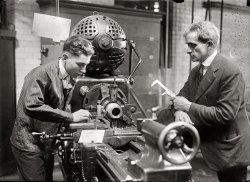
- Ice Men: 1941
- ... to know.
Fuzzy Memory I lived in Fairlington in Arlington from age 2 thru 5. My distant memory may be deceiving me but I seem ... Posted by Dave - 02/26/2013 - 10:53am -
![Ice Men: 1941 December 1941. Washington, D.C. "Diners in Washington Hot Shoppes restaurant." An exciting night of ice skating awaits, or has just concluded. Medium format nitrate negative by John Collier. View full size.
Close to HomeLived in a small garden apartment complex just up Yuma Street from where this Hot Shoppe was located. It had a drive-in as well. Good to know that the 'Ice Palace' building has not been altered that badly over the years, hope WMAL [ABC] stay there for a long time. There used to be a Mercury dealer on the other side of Yuma Street from this restaurant.
Celebrity look-alikesThe guy at the left front of the table looks like a young version of the blond half of the Siegfried and Roy (Las Vegas and white tigers) act. The guy reflected in the glass block mirror (sitting with a girl) looks like a young Jimmy Stewart. The plates of food look like burgers and fries.
mirror. mirrorI love the woman in the mirror who is checking out the photographer.
Poor plants.Those stringy philodendrons need some tender loving care!
Material for Future NostalgiaSoon this prosaic scene will be remembered with some poignancy should either of these young men end up at Guadalcanal or Anzio or Omaha Beach. In Vietnam, I found myself recalling fondly such odd moments as spaghetti day in my elementary school's cafeteria or the day Suzie Egan smiled at me for no good reason. The recollection of an evening's skating, followed by a burger with a friend, and all the while nobody's shooting at you ... priceless!
Re: BottleThe same type of bottle is seen at Girls' Night Out: 1941 but also lacking a view of the label. I too would guess ketchup but have been unable to find anything similar on the intertubes.
I'm also curious what was in the bowl with the metal lid. Relish? Sugar?
[Another Hot Shoppe shot shows that bowl seemingly immediately before or after use. - tterrace]
Nice Collar Flipon the blonde guy. The Army will straighten him out.
Across from the Ice PalaceCould this be the Hot Shoppe across Connecticut Ave. from the Ice Palace? (approx 4400 block) In 1941, we ate dinner there before going skating with the Washington Figure Skating Club. Full dinner was either 66 or 88 cents depending on whether you got dessert. Note the coin box on the wall for the jukebox. The Marriotts thought their choice of music was superior to what the diners might choose. After WW2, what had been the Ice Palace became the studios for Channel 7.
The Hot ShoppesI remember when the Hot Shoppes operated the restaurants on the NY State Thruway. It didn't matter what time of day or night you went there, there would be someone mopping the floor with some smelly ammonia based liquid.
What's in the bottle?I'm not quite old enough to remember what it might hold, but any idea what's in the shapely bottle closer to our diner on the right?
At first I thought it might be some long-forgotten beverage, but it appears to have rings in the glass neck, so maybe it's ketchup. Or a Hot Shoppe special topping? But where's the label?
Inquiring, somewhat younger, minds want to know.
Fuzzy MemoryI lived in Fairlington in Arlington from age 2 thru 5. My distant memory may be deceiving me but I seem to remember there was a Hot Shoppes in the Shirlington Shopping Center not far away. My mother went shopping in Shirlington a lot and I can picture myself as a young tyke eating there on occasion. Same booths and table setups. Anyway, Hot Shoppes is gone but last I knew Shirlington lives on.
Chevy Chase Ice PalaceWhere the Ice Men cameth from...
Before or afterIt appears that both men have their trousers cuffs rolled up.
Easier to skate with not so much material in the way
Sooooo, I would assume it is an after skate snack.
Apres Skate?Seeing the young men's cuffs rolled up that they had already had their "skate." I used to do the same, as a kid, when I roller-skated around the neighborhood - and, of course, one cuff rolled up when riding my bike.
Sugar, sugarI'm fairly certain the bowl with the metal lid is a sugar bowl. (This was before sugar came in little packets.) The hinged lid allowed one to level the teaspoon before removing it and prevented spills on the way to the coffee cup.
Sugar cubes were also sometimes used at places like this and often stuck together in the bowl. When I was a kid we would sometimes stick our fingers in the sugar bowl (yuck!) and grab one or two cubes to suck on.
Condiment ChoicesThat condiment bottle does look like ketchup, which wasn't always blood-red, according to oldsters in the know. Some ketchup was more orangey-red before artificial coloring became widespread. My maternal grandmother used to make her own ketchup when we had a particularly good tomato crop. I remember it being acidic and tangy and quite runny, not so sweet like the corn-syrup laden goo sold today. She canned it with a paraffin wax seal and served it right out of the jar with a spoon. Right beside it was her homemade chow-chow sauce, another tomato-based condiment that contained finely-chopped onions and hot peppers, vinegar, and salt. Both of my grandmothers made chow-chow, maternal "Mimi" made it soupy and paternal "Mamaw" made it chunky.
"Ankle Beaters"What they called it in the 50's when you wore your jeans like that.
(The Gallery, D.C., Eateries & Bars, John Collier)](https://www.shorpy.com/files/images/SHORPY_8c33644a.thumbnail.jpg)
- Old Money: 1915
- ... audience invariably joined in.”
Next time I visit Arlington National Cemetery, I'll pay my respects to jolly Mr. Taft!
... Posted by Dave - 09/11/2011 - 1:27pm -
![Old Money: 1915 Washington circa 1915. "Miss Louise Lester, in charge of mutilation of old money at Treasury Dept." View full size. National Photo Company glass negative.
$5 million per dayThe following is from a caption for a similar photo of the same apparatus. Miss Lester was one of a committee of three which supervised the daily destruction at the Bureau of Engraving and Printing.
Washington Post Jun 2 1912
U.S. Officials Destroy $5,000,000 Daily in Worn out Currency
The money at the rate of nearly $5,000,000 is thrown into the receptacle at the bottom of the picture. Under this is the machine that cuts up the old bills into tiny bits. Later the mass is mixed with a solution that takes out all coloring matter, and the pulp is then sold to manufacturers of cardboard and paper pulp novelties. The woman in the picture is Miss Louise Lester, the only one of her sex to ever serve on this committee. She was recently appointed by President Taft from Maryland.
Messy JobHow did she stay so neat and clean in such a messy environment? Wish I knew more about the process such as what the wash tub was for and why the use of water.
Filthy LucreInteresting occupation! I wonder what exactly the process would be for money "mutilation." And I wonder if Miss Louise ever dipped into that big bin of moolah!
WheeAnd Miss Louise looks thrilled to be doing her job!!
Mutilation?!Oh man, I guess I would have the same expression if I was in charge of "mutilation of old money"!! That place looks like a bomb shelter.
[I think the technical term was maceration, although "mutilation" seems to be what's written on the negative label. Someone at the LOC transcribed it as "metalation." Tomayto, tomahto. - Dave]
FinallySomeone with a messier desk than mine!
Louise Lester's Later Life of LeisureLarcenous Louise Lester later loaned her bother Larry a half-million dollars, leaving a little left for her lonely lesbian lover, Lottie. Louise and Larry learned of a leaky log house in a lower latitude and linked up there to live a life of leisure studying literature and laughingly learning to play the lyre. Lottie was left behind, later to have a lobotomy.
[And after they died, they both went straight to ...
- Dave]
Ahem....From the looks of it, "Old Money" had to endure a great deal of torture before it was ultimately mutilated into submission! - Kathleen
OMG, She's a ...Serial Killer! As in mutilator of serially numbered currency! Get it?? Yes?
Taft ROCKED the White House. Responsible for the cherry trees along the Tidal Basin AND appointing the first female money mutilator!
The only President to also have served as Chief Justice.
A faithful husband and doting father.
Roosevelt's troubleshooter who helped supervise the Panama Canal construction.
And a merry 350 pounds, with an infectious chuckle! His biographer described Taft's famous laugh this way: “It was by all odds the most infectious chuckle in the history of politics. It started with a silent trembling of Taft's ample stomach. The next sign was a pause in the reading of his speech, and the spread of a slow grin across his face. Then came a kind of gulp which seemed to escape without his being aware that the climax was near. Laughter followed hard on the chuckle itself, and the audience invariably joined in.”
Next time I visit Arlington National Cemetery, I'll pay my respects to jolly Mr. Taft!
Community ChestI wonder what filled Miss Lester's blouse on the way to work.
An off dayThe photo must have been taken on an off day. Miss. Lester said in an interview that "While my work is somewhat 'messy' it is interesting and does not grow monotonous. It's really fun!"
http://fultonhistory.com/Process%20small/Newspapers/Oswego%20Palladium/O...
Yikes.No, no. No. Nothing in this room says, "fun." Fun and this room, not in the same world. I've really never seen a more depressing situation. Even macerating old money could be done in a far less depressing room. Yikes.
(The Gallery, Curiosities, D.C., Natl Photo)](https://www.shorpy.com/files/images/19174u_0.thumbnail.jpg)
- Abe Cohen: 1922
- ... 71, senior member of the firm of Abe Cohen & Son, Arlington, Va., manufacturers of commercial laundry machines, died yesterday at ... Posted by Dave - 08/07/2012 - 2:16am -
![Abe Cohen: 1922 Washington, D.C., circa 1922. "Abe Cohen." Probably not Abe himself, but you never know. This is just the kind of malevolent-looking contraption that keeps Stephen King in business. National Photo glass negative. View full size.
Wet rugsOne of my cousins owned a dry cleaning business, and they had the same contraption. It was used to dry wet rugs. You would be surprised just how heavy a wet rug is!
Anyone who has operated one of these drying racks can tell you that they aren't all that "heavy duty."
The wheel goes up and down with the rack. This means that when you raise the lower rack, the wheel is "over your head" (a real back breaker). The upper rack is stationary.
Goodbye, Mr BondSo many weird devices on Shorpy bring those classic words to mind. Actually, I believe the wheel raises the upper rack. One reason to adjust it would be to bring it within reach - of Mr Cohen or his employees, his wife, or his zombie. It certainly could be used to stretch something, but I'll cast my vote for drying rack. Perhaps it was used at a hospital for drying linens, like those we see ... drying. Lots of overbuilt equipment in old hospitals - see any movie about shuttered mental institutions. Also, one-offs then and now were likely to be built out of whatever was at hand - perhaps pipes and a crank were just available and easily cobbled together.
Ink JetI think that’s what the inside of my printer looks like.
Rug washing and dryingI read an article in the local newspaper about the oldest laundry and dry cleaner in my hometown. Back in the day, besides providing a laundry service for clothing, the company also washed rugs and hung them in the attic to dry.
This looks like a drying rack for area rugs (no wall to wall back in the day) with a height adjustment.
OY!This looks like something in the oral surgeon's office my mother tricked me into "visiting" in the early 1950s. My mouth still hurts.
OverbuiltThe bottom rack appears to move up and down with the turn of the handle. Why is this thing so overbuilt, was it used to stretch fabric?
Abe needed a broom.Looks to my eye like a drying rack. Abe could have used a rake as well.
Noodles? Lasagna?I would guess Abe made his own pasta and air dried it on this contraption.
To the Rack!It's almost definitely a fabric stretcher. The ratchet on the hand wheel is directed to pull the lower rack down away from the upper one.
I find the chain wrapped around the rafter to be more sinister.
WMPWeird mysterious photo, the kind I like.
Stretcher / Drier?Yeah, it seems to me like it's intended to keep something under tension as it dries. Not only is there a rack (as in a linear gear) and pinion arrangement to move the lower rods, but there's also a large toothed cog. It doesn't engage the rack (there's a smaller pinion for that), but there's a movable pawl that engages the cog to lock the whole arrangement in the desired position.
Based on the size of the crank wheel and the pawl arrangement and everything else, this looked like some serious muscle was used. I'm wondering if the fabric mats (?) hanging in the back may have been the sort of object dried here.
[Below, another view of the drying rack. The top half telescopes down into the bottom half. - Dave]
Abe Cohen's Stage Namewas Ron Popeil! Anyone can clearly see that this is an early version of the "Bamboo Steamer!"
Maker of MachineryWashington Post, August 22, 1949.
Abe Cohen, 71, Dies;
Maker of Machinery
Abraham (Abe) Cohen, 71, senior member of the firm of Abe Cohen & Son, Arlington, Va., manufacturers of commercial laundry machines, died yesterday at Garfield Hospital after seven weeks' illness.
Funeral services will be held at his home, 1437 Geranium st. nw. Burial will follow in the Washington Hebrew Congregation Cemetery.
Well known in the United States and Canada, he had been associated with the laundry business for 50 years, and a member of the firm that bears his name for the past two decades.
He was born in Glasgow, Scotland, and came to America at an early age. Cohen was a member of St. Johns Lodge No. 11 of the F.A.A.M., Almas Temple of the A.A.O.M.A., a 32nd-degree member of the Scottish Rite, the Washington Lodge No. 15 of the B.P.O.E. and the Rosslyn Business Men's Association.
Surviving are a son, Moritz. A. Cohen sr., two grandchildren, Moritz A. Cohen jr. and Virginia Louise Cohen, and 10 nieces and nephews, all of Washington.
Curiosity Killing the CatWell Dave, are you gonna tell us what this creation is or not? Do you think its fair to put that out there with nary a clue or explanation? Is there a prize for figuring out why it was created? Why is the name "Abe Cohen" used in the title? Is that a steering wheel that can be driven in different directions? Why does it have wheels? What are the blankets for? Is it used with the chains wrapped up there in the rafters? What do you know about this that you are not telling? Inquiring minds want (and need) to know. Don't just leave us hanging.
?????I don`t know what it`s for, but the top half retracts into the bottom.
It's not overbuiltIf you're going to drip-dry eight woollen blankets (which is probably what this is for) you need something made out of steam pipe.
Its similar to the drying racks in the laundry of Berrington Hall, a country house in Herefordshire in England (see pic). You fill them up with clothes and slide them in on rails on either side of a special drying furnace.
Mind you - it would be a good place to hide a body too (but Miss Marple would know where to look).
Severely overengineeredThis is an extendable clothes drying rack. The top half can be extended by a rack-and-pinion system. The rack gear can be seen on the vertical tubes in the middle. The ratchet wheel behind the hand wheel prevents the upper half from crashing down again.
I have a hunch that Abe Cohen may have been a pipe fitter, looking to branch out.
(The Gallery, D.C., Natl Photo)](https://www.shorpy.com/files/images/SHORPY_31781u.thumbnail.jpg)
- Carrying-In Boy: 1911
- ... available. His oldest brother, Bradley Kidd, was buried in Arlington National Cemetery on March 13, 1952.
Rob Kidd I have a ... Posted by Dave - 08/15/2012 - 9:47am -
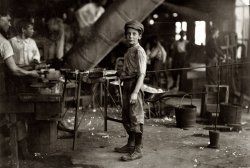
- Havana Harbor: 1904
- ... already been removed from the USS Maine and hauled off to Arlington.
A paean to the hosts
It's a continual source of enjoyment ... Posted by Dave - 09/08/2013 - 11:03am -
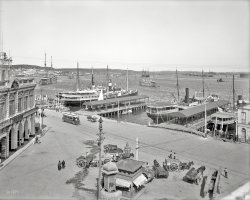
- The Busy Corner: 1934
- ... monkeys! I remember Kann's. There was also one in Arlington (where the GMU Law School is located now). I was fascinated as a kid ... Posted by Dave - 08/03/2014 - 9:45am -
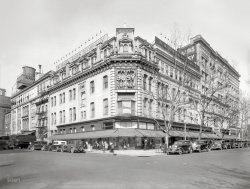
- The Rest of the Store(s)
- ... Strosniders still has thriving locations in Bethesda (Arlington Road & Bradley) and Potomac Village.
Woodmoor Supermarket ... Posted by Dave - 11/18/2013 - 6:13pm -
![The Rest of the Store(s) Continuation of the scene last glimpsed here, with the Acme supermarket at right. Silver Spring, Maryland, circa 1948. "Acme Market. Four Corners -- Woodmoor Shopping Center, Colesville Pike and Old Bladensburg Road. Schreier & Patterson, architects." Photo by Theodor Horydczak. View full size.
Three grocery stores?This second photo appears to have a DCS (?) Supermarket at the far left end, another small, unsigned grocery store in the middle, with two men standing in front, plus our Acme Supermarket on the right.
Did that small plaza really have three places selling food items? If so, at least parking was probably always available nearby for each.
FinsThe Cadillac on the right is gorgeous. And at least its owner washes it!
1949 CadillacThe Cadillac on the right is a new 1949 Series 61 coupe, so it must be late 1948 or spring 1949.
'49 is fineGreat looking '49 Cadillac fastback -- a car is a car, but that is a RIDE!
Blast from the PastHave been exchanging email with my sibs over the Acme photos. We grew up in the Four Corners area, ca. 1947--1962 for me. We used to walk past the Acme twice a day, along what was then University Boulevard, to and from St. Bernadette's school (right or to the east).
The "Hardware-Auto Supplies" was (by the fifties) Strosnider's Hardware. I don't remember what most of the other merchants became, but.... The "Groceries" became a savings and loan, where I had my first savings account (which paid more interest--4%--in the mid-fifties than you can get now!). The dark area to the left of "Groceries" was an arcade. Through the arcade on the left was a barber shop and a realty office. On the right was a stair up to the second level, which housed the library, where I spent many an hour. (In later years, the library relocated all the way to the left of the strip.) Also on the right of the arcade was a TV repair shop, where I had many a tube tested.
Bowled ThereThere was a bowling alley downstairs at Woodmoor. It was duckpins of course; even after Fontana's opened around the corner I don't think there were tenpins in that neighborhood until the mid 60's.
Dr. Thibodeaux had his office there for a long time, too.
The Most PowerfulCar in the lot sits proudly by itself! The 1949 Cadillac, in a world still being propelled by flat head six and straight eight puddle jumpers with a maximum horsepower of maybe 120, the brand new 160 horsepower overhead valve V-8 sitting in the second year of the 1948 body, is the wave of the future and the 50's! With its four-speed Hydra-Matic, it can literally peel out of the lot and leave any of the other cars in its dust! When the accelerator is floored, the rear end squats down and the front end rises up with it beautiful hood goddess leading the way!
Still there and much improved The one thing you can not do now is park your Caddy on the shoulder of what is now University Blvd. Also the center of the photo is what is under the Woodmoor sign today. And if that Hardware store would later be Strosnider's Hardware they live on in downtown Silver Spring. The Arcade is still there it leads to a parking lot in the back.
The modern viewI'm pretty sure this is the correct view, today. Interesting to see the contours of the buildings maintained when they built the 2nd floor.
View Larger Map
Even More WoodmoorWoodmoor Shopping Center was developed by Standen and Chester Keller who later developed Beltway Plaza and what would be known as Hechinger Plaza.
The flagpole rises over the area's first Post Office, which moved to larger nearby quarters in August 1961. To its left was the Woodmoor Bakery. A bakery fire in the '60s leveled part of the strip, but second story offices were added during reconstruction.
In addition to their hardware store, Strosnider's also originally ran the 5 & 10, but Strosnider son-in-law Larry Olsen would assume the business; moving it into the old P.O. site. The original 5 & 10 site then became China House Restaurant.
Only phase one of the shopping center is visible in this photo. In the '50s, the strip expanded northward (left) bringing a Peoples Drug Store, Liquor and Gift Stores, the Woodmoor Lanes, a Suburban Trust bank and a larger Montgomery County Library.
The downstairs duckpin alley that Lewisdale John remembers closed suddenly and was replaced for a while by Slot Car Racing. Ultimately, the cozy cellar became the permanent home of the Silver Spring Stage players.
Instant recognitionI recognized Woodmoor instantly, for in spite of many changes of stores the buildings look very much as they did forty years ago, modulo some careful renovation. The florist on the corner (which I think, from this shot, replaced part of the Acme) still even has its original neon sign on the roof.
Woodmoor DeliThe store with the Groceries sign is the old Woodmoor Deli. It was run by two WWII vets - one of which sported a tattoo of a Hula girl captioned New Guinea 1944. I bought my first six pack of beer there long before I should have been allowed to.
That Cadillacmay be a '48. All of the Caddy pics I can find online show only the '48s with a single backup light, although some '48s also had two.
[1948 Cadillacs had three chrome "whiskers" under each taillamp. - Dave]
The 1948 Series 61 Sedanet didn't: note also the single backup light.
2 grocery stores and a deliThere was the Acme Supermarket, the Federal Market and in between (where you see the Groceries sign) was the Woodmoor Deli. The Deli was owned and operated by two WWIi vets - Fred and George I believe. George was a big man and sported a faded tattoo of a Hula Girl captioned "new Guinean 1943).
I bought my first 6 pack in that Deli and though it was not my name, George called me "Marty" for years due to a name printed on an old uniform shirt I wore while pumping gas at the ESSO.
BowlingThe basement duckpin lanes at Woodmoor didn't have automatic machines, but pin spotters who jumped down and reset the pins manually. Fontana's at University and Carroll had two levels - one tenpin and one duckpin; went to many a birthday party there.
In addition to Silver Spring, Strosniders still has thriving locations in Bethesda (Arlington Road & Bradley) and Potomac Village.
Woodmoor SupermarketI lived in the neighborhood behind the Woodmoor Shopping Center, on St. Lawrence Street, for just over a year in the mid 2000s. I bought a ton of wine at the Woodmoor Supermarket/Beer and Wine store. While my wine was usually of the boxed variety, that little store had an impressive beer and wine selection back then.
(The Gallery, Cars, Trucks, Buses, D.C., Stores & Markets, Theodor Horydczak)](https://www.shorpy.com/files/images/SHORPY_5a42645u.thumbnail.jpg)
- Miss Dead Letter: 1916
- ... Clara Nelson died on May 12, 1963, and she was buried in Arlington National Cemetery on May 17, 1963 beside her parents. A photo of her ... Posted by Dave - 08/29/2012 - 2:12pm -
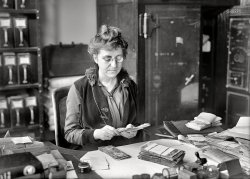
- Tree House: 1923
- ... in storage at the Agriculture's Experimental Farm in Arlington, Virginia. In 1940 the Farm was transferred to the Army for part of ... Posted by Dave - 12/11/2011 - 10:45am -
![Tree House: 1923 Washington, D.C., 1923. All it says here is "Dept. of Agriculture." Back when the place was run by the Keebler Elves. National Photo Company. View full size.
Noble Redwood Tree HouseMore photos here:
This was the General Noble Redwood Tree House – a 50-foot section of a 2,000 year-old giant sequoia tree. This idea was conceived as an impressive government exhibit for the 1893 World's Columbian Exposition in Chicago.
The tree was cut in the General Grant National Park – which is now Kings Canyon National Park in California. A team of twenty cutters worked for seven days, fifty feet above the ground, to cut the 26-foot diameter tree.
Workers then hollowed out the stump, and cut the tree into some 2-3 dozen sections, which would be reassembled on the site of the exposition – complete with an interior circular staircase!
In 1894 the tree was moved again to the grounds of the Agriculture Building, on the Mall in Washington, DC. It was then that the structure was made waterproof with the addition of a peaked roof and four dormer windows, and covered with redwood shingles.
The tree house remained on the mall until 1932, when it was placed in storage at the Agriculture's Experimental Farm in Arlington, Virginia. In 1940 the Farm was transferred to the Army for part of the Pentagon grounds, and the tree was likely burned at that time.
Early LOTR StyleI think that's where Gandalf used to live. He eventually had to move out because of all the carpenter ants (his "Jedi tricks" had no deterrent effect upon them). Nowadays he's in a Tampa condo.
Jefferson Drive at 12th StreetTo the right is the Department of Agriculture to the left is the Freer Gallery. Between them is 12th Street SW, a service road and tunnel under the Mall. I crossed the Mall, 100 feet from there yesterday morning. The tree house is gone but the two buildings are still there.
Tree FarkFarked again!
Original TIFF?I've searched high and low for the higher-res source file of this image on the library of congress site and elsewhere and I can't find it for the life of me. Could anyone point me in the right direction?
[It's here.]
(The Gallery, Curiosities, D.C., Farked, Natl Photo)](https://www.shorpy.com/files/images/SHORPY_30519u1.thumbnail.jpg)
- Window Shopping: 1943
- June 1943. Arlington, Virginia. "Ordering clothes from a mail order house at Idaho Hall, Arlington Farms, a residence for women who work for the U.S. government for the ... Posted by Dave - 05/25/2016 - 12:40pm -
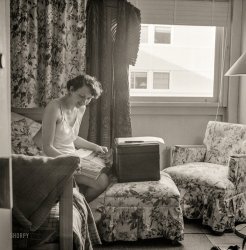
- Lotion Locker: 1943
- June 1943. "Arlington, Virginia. Mirrors over the dressing table conceal a cabinet which gives girls extra space for their cosmetics, etc., at Arlington Farms, a residence for women who work in the government for the ... Posted by Dave - 10/23/2019 - 12:34pm -
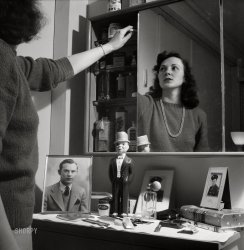
- Come Play With Us: 1925
- Arlington, Virginia, circa 1925. "Happy Walker Orchestra." On certain moonless ... Posted by Dave - 10/04/2011 - 10:02pm -
![Come Play With Us: 1925 Arlington, Virginia, circa 1925. "Happy Walker Orchestra." On certain moonless nights, the old porters say, you can still hear them going at it. View full size.
ZonkedThat trumpet player looks like he has finished a large measure of bathtub gin and is thinking, "If I just sit here very still, I won't fall off of this chair. Ohhhh, I think I'm gonna be sick."
Mellophone on the floorOn the floor next to the trumpet player is an E-flat mellophone. I had to play the school's horn when I was in 5th and 6th grades. There was always gum in the mouthpiece, thanks to the girl who played it in the high school band (it was a small school),
Bass SaxThat big bass sax reminds me of the Basil Fomeen band which played in the Congo Room at the Carlton Hotel in DC in the 1950s. The ONK! ONK! of that sax was characteristic. Unfortunately the band was well beyond its prime and was pretty terrible ... but they were in LIVE!! HiFi on the Continental FM Network (funded by Maj Edwin Armstrong of FM fame). It seems that the Carlton has become the St Regis Hotel at 16th and K.
Michael Scott!Is that Steve Carell with the violin?
The CountCount Dracula on Piano.
Which one is Happy Walker, is he the Undertaker with the Violin?
Nino SaxLooks like our reedman's slinging a Sopranino Saxophone; the straight one standing up next to the oboe. B-flat and C sopranos saxes are about the same length as a standard B-flat clarinet; the standing straight saxophone is noticeably shorter, so odds are it's a sopranino. The tiny horn slung on the stand to the player's left might be a curved version of the Sopranino as well, but might just be a B-flat curved soprano. Hard to tell from the angle.
When Adolphe Sax invented the horn in the late 1830's (the first saxophone patent was filed about 1841) he described and built a family of saxophones ranging from the high end sopranino all the way down to contrabass.
Outside the alto saxophone, marching band music and a few orchestral composers, for years nobody much took saxophone very seriously; it really took American jazz to make it a broadly recognized and respected instrument. In the Teens and 1920s the entire saxophone family came into vogue, though outlying family members like the sopranino tended to be treated as novelty instruments.
Re the comment above - that's not a Bass sax, it's a mere Baritone. Bass saxophones are ginormous:
http://en.wikipedia.org/wiki/Bass_saxophone#Gallery
Not that a Baritone can't honk -- boy can they!!
Lots of bands in the '20's deployed the Bass Saxophone where a tuba would normally be used - they occupy the same subterranean sonic territory.
Spit and PolishLooks like they all stopped at the shoeshine stand on the way to the ballroom.
StrangeThe fellow standing isn't Happy Walker; the fellow on trumpet at the left doesn't really look like Walker, where is Walker? And they've lost the bass player? A mystery for the ages, I suppose.
OK everyone, smile and blink your eyes!Thanks to T.K. Torch for the interesting history on the instruments! I never knew where the saxophone got its name, until now!
I don't know that much about photography, but wouldn't the weird eyes have come from the shutter speed being a bit slow?
[The "zombie look" characteristic of flashlight photos comes from the subjects' eyes being both open and closed during a magnesium-powder exposure, where the shutter, not being synchronized with the flash, is opened before the charge is ignited and closed after it goes out. - Dave]
Thanks for the explanation!
That tall violinist is pretty handsome, despite the "zombie look"!
Altogether now,Silk lapels and socks, striped vests and hair parted in the middle, a one and a two !
Busy sax manI wonder if he got a bigger cut than the others? That's a lot of instruments to play (and to maintain!)
What a difference two years makesThe boys in the band have changed remarkably from the 1923 photo posted a couple days ago. In fact I don't think it's the same guys at all.
Could it be that we're looking a 2 different bands here: the Happy Walker Orchestra and Happy Walker's Madrillion Society Orchestra?
Take my life, but please don't take my banjo!Which is what the face of the banjo player, and corresponding grip on his instrument, seems to be saying. And the look on the trumpet player's face. Jeb70 seems to have hit the nail on the head.
And the sax player bears a slight resemblance to Adrian Rollini, who was one of the kings of the bass sax for most of the 1920s.
(The Gallery, D.C., Music, Natl Photo)](https://www.shorpy.com/files/images/SHORPY_31970u.thumbnail.jpg)
- The Silent Army: 1925
- May 26, 1925. "Gen. Pershing at Arlington National Cemetery." Standing watch: masts for the Navy's wireless ... looks different because when they become worn at Arlington headstones are replaced if they are damaged or if the writing on them ... it seems that H. G. Well's tripod invaders are marching on Arlington as we watch.
Normal Accoutrements Lest the casual viewer ... Posted by Dave - 05/25/2015 - 2:26pm -
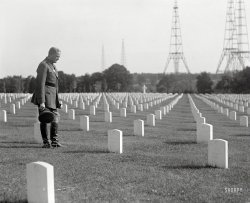
- Here Come the Bridesmaids: 1924
- May 6, 1924. Arlington, Virginia. "Byars-Coontz wedding." The union of Miss Virginia Byars ... was interred not far from wherever this photo was taken in Arlington. See here .
A somber occasion As my late mother would say, ... Posted by Dave - 10/28/2016 - 12:52am -
![Here Come the Bridesmaids: 1924 May 6, 1924. Arlington, Virginia. "Byars-Coontz wedding." The union of Miss Virginia Byars to Lieut. Kenneth Lee Coontz, son of Admiral Robert Coontz. National Photo Company Collection glass negative. View full size.
Little boy lostPresumably the usher standing with arms crossed amidst encroaching bouquets. His outfit was not designed to bring a smile to his face.
[He's most likely the ring bearer, and his feminine counterpart the flower girl. -tterrace]
Can I go now?That little boy looks thrilled to be part of the festivities.
Tragic end to the union?ADM Coontz served as the second Chief of Naval Operations. His son, the groom, died on active duty, apparently two years after this photo was taken, and was interred not far from wherever this photo was taken in Arlington. See here.
A somber occasionAs my late mother would say, when taking a picture, "Would it kill you to smile?"
Ghastly GarmentsIt's nice to know that bridesmaids dresses have always been useless once the wedding is over. And what's with the bride, who looks like she's trying to figure out a way to get out of the wedding?
Virginia lived a long lifeUntil the age of 98.
Groom & doomThe wedding earned an entire column of coverage in the May 7, 1924 New York Times. The matron of honor in this photo was the First Lady of Virginia and the flower girl, her daughter. The happy couple planned to move into the Wardman Park Hotel, home of many a Shorpy subject, to await the groom's return to service in the Pacific that fall.
In its brief September 26, 1926 report on Lt. Coontz's death, the Times stated that it followed an illness of more than a year, and that he had undergone several major operations. The Associated Press had mentioned cancer.
Son of the brideObituary here.
(The Gallery, D.C., Kids, Natl Photo, Weddings)](https://www.shorpy.com/files/images/SHORPY-11311u.thumbnail.jpg)
- Chain Bridge: 1865
- ... of the District of Columbia. The boundary line between Arlington, Virginia and Washington, D.C. is the high tide line on the Virginia ... Posted by Dave - 08/02/2012 - 3:09pm -
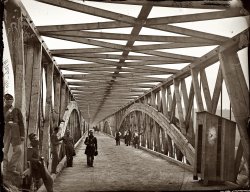
- Known But to God: 1943
- ... AN AMERICAN SOLDIER
KNOWN BUT TO GOD
May 1943. Arlington, Virginia. "Sailor and his girl at Tomb of the Unknown Soldier, Arlington National Cemetery." 4x5 inch Kodachrome transparency by John Collier ... Posted by Dave - 05/30/2018 - 5:01am -
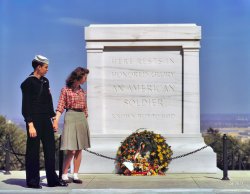
- Long Distance: 1921
- ... audio from the Nov. 11, 1921, Armistice Day ceremony at Arlington National Cemetery, where Warren Harding spoke over the casket of the ... is the delicate machinery being installed beneath the Arlington Amphitheater which will amplify the President's voice one thousand ... Posted by Dave - 02/07/2015 - 1:57pm -
![Long Distance: 1921 Some of the "amplifying telephone" equipment that carried audio from the Nov. 11, 1921, Armistice Day ceremony at Arlington National Cemetery, where Warren Harding spoke over the casket of the Unknown Soldier, to loudspeakers set up for the crowds outside as well as in New York and San Francisco. More here.
November 1921. "This is the delicate machinery being installed beneath the Arlington Amphitheater which will amplify the President's voice one thousand billion times when he makes his address on Armistice Day in honor of America's Unknown Warrior." Harris & Ewing Collection glass negative. View full size.
The Four Black BulbsUp on the ceiling in sockets, possibly they're used as some sort of a load? They're dark glass as to not cause unnecessary brightness in the space when in use. Early in my career I was working on a 1500 watt power supply that needed to be load tested. The resistors and parts to build the load would have been hundreds of dollars (a lot in 1980) Instead we bought 15 light sockets and 15 100 watt bulbs and wired them up to get a 1500 watt load. Cost was under $50. Seeing these bulbs on the ceiling brought back that memory. I also could be totally wrong.
[I suspect they're red. - Dave]
Nothing made of plastic to see hereThat equipment would still work now, almost 100 years later.
[None of this would have been possible without plastics, chief among them the synthetic resin Bakelite. - Dave]
300 dBOne thousand billion! That's a lot of wattage from this cottage. Maybe someone else knows what that works out to in 'jigawatts'.
Raised flooringThis is a very early example of raised flooring for cabling. AT&T began using raised floors in mid '80s.
Secret Cellar I wonder what they use this space for today?
Western ElectricThe tubes shown are Western Electric "tennis ball" types, probably 101D or 102D, but possibly also 104D or 205D. Any of which can be worth $1,000 today. Clearly what is shown is really just a preamp-level gain stage setup, any real power amps would have been bigger, and used different tubes.
Zinc-plated, vacuum-tubed cultureHand me a Stone knife and another Bear skin, Carl.
Rectifier TubesThese early hulks are quite interesting. This example was made by Westinghouse for license to Western Electric as seen on the decal.
Amplification factorThe amplification factor of "one thousand billion" may not be as wild as it seems. A modern dynamic microphone only produces a couple of nanowatts of power. Dynamic and ribbon microphones were not yet available, but the condenser microphone had been invented by Bell Labs in 1916. While carbon microphones (used in telephones) had high power output, their audio quality was poor. If a condenser microphone was used, the stated amplification factor would translate to tens or at most hundreds of watts delivered to the loudspeakers.
(Technology, The Gallery, D.C., Harris + Ewing)](https://www.shorpy.com/files/images/SHORPY-14434a.thumbnail.jpg)
- Peewee Posse: 1936
- ... Thing It doesn't look like that now. As a "suburb" of Arlington, Texas, it's surrounded by a metropolitan area of millions of people. ...
Still semi-rural While surrounded by the city of Arlington, Dalworthington Gardens itself it still somewhat semi-rural, but now ... Posted by Dave - 02/07/2013 - 9:36pm -
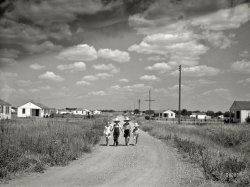
- W.S.S.: 1917
- ... BRIDGE WHICH IN CONNECTING
THE NATION’S CAPITAL WITH ARLINGTON SHA…
and the bottom line ends with
GREAT ARMY OF THE REPUBLIC
Construction of the Arlington Memorial Bridge didn't begin until nearly 10 years after this photo ... Posted by Dave - 09/12/2011 - 12:46pm -
![W.S.S.: 1917 Washington , D.C., circa 1917. "W.S.S. poster." (Aha. So that's what it is!) Harris & Ewing Collection glass negative, Library of Congress. View full size.
Where this isI was able to make out some of the text on that mysterious cornerstone:
UNION OF WASHINGTON O.G.A.S ….
OF THE MEMORIAL BRIDGE WHICH IN CONNECTING
THE NATION’S CAPITAL WITH ARLINGTON SHA…
and the bottom line ends with
GREAT ARMY OF THE REPUBLIC
Construction of the Arlington Memorial Bridge didn't begin until nearly 10 years after this photo was taken, although plans for the bridge were made around 1901 or 1902. I would love to figure out the name of the theatre behind this billboard...that might provide a clue about the location.
[From a 1902 article in the Washington Post: "It is the desire of the Stone Cutters' Association that the stone be placed on government property in some prominent location, preferably on Lafayette Square." A cavity in the stone contained Washington newspapers, a Grand Army badge and a copy of the Stone Cutters Journal. - Dave]
Billboard BubblesThe billboards I see today appear to have much smoother surface than the one in the picture. It seems to have a lot of air bubbles. They must have a much better squeegee system now.
Puzzle SolvedThat's the Belasco Theatre on Madison Place.
http://cinematreasures.org/theater/7618/
Comedy is too easyShakespeare dropped his middle name when he started doing tragedies.
War Savings StampsBillboard for War Savings Stamps to help the war effort. I still have my War Bond given to me by my parents from World War 2.
Before BondsThat was a shorthand expression for "Buy War Savings Stamps." Either that, or Microsoft Windows Sharepoint Services is older than I thought.
CornerstoneThat cornerstone is pretty interesting. It appears that it is dated as 1902 (MDCCCCII), yet the picture is dated 1917. I also notice that the cornerstone edges are protected by wood cornerguards as if it getting ready to be installed, yet the billboard latticework was cut out to accommodate the stone, implying it was there before the WSS! advertisement.
War Savings Stampswere sold in both WW1 and WW2 to help finance the cost of the wars. They came in 10 and 25 cent denominations, and were aimed at school children. During WW1, the Boy Scouts were heavily involved in promoting and selling them.
During WW2, you could paste them into special booklets and, when filled, the booklet could be redeemed for a $25 War Bond. I was very proud when I got that Bond, doing my kid bit to win the war.
(The Gallery, D.C., Harris + Ewing)](https://www.shorpy.com/files/images/09966a.thumbnail.jpg)
- Enter Front: 1935
- ... you can see the center rail.
This is Rosslyn VA The Arlington Trust Co was on N. Moore St. and Lee Hwy. There was a circle on the ... Posted by Dave - 06/07/2014 - 12:10pm -
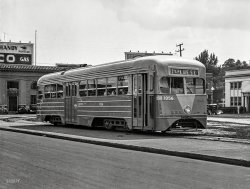
- Enter Subway Slowly: 1904
- ... ramp from underground when traveling between Boylston and Arlington stops.
There used to be a great site about the MTA/MBTA's ... Posted by Dave - 08/14/2012 - 12:54pm -
![Enter Subway Slowly: 1904 Boston, Massachusetts, circa 1904. "Descent into subway, Public Garden." 8x10 inch dry plate glass negative, Detroit Publishing Company. View full size.
SubwayspottingThis entrance was only used for a short period and was sealed in 1914. You can still see the ramp from underground when traveling between Boylston and Arlington stops.
There used to be a great site about the MTA/MBTA's history, including abandoned stations and entrances; it's apparently disappeared but is preserved by the Wayback Machine. If you're a trainspotter like me you'll love it.
[Below, the tunnel marked with the year 1895. - Dave]
The old A LineThe car on the far right in the foreground is heading toward Park Street on what would become the old A branch of the Green Line. Current Boston commuters know the four lettered Green Line branches (B, C, D, and E), but until the early 70s the A branch ran with the B until splitting off at Comm Ave and Brighton Ave and then running through Oak Square, Newton Corner, and ending at Watertown Square.
A tisket, a tasketWhat is the purpose of the wicker basket?
The "wicker basket"It's a wooden bucket that most likely contained sand for traction on wet or snowy days so the trolleys could climb up grade and also for assisting in braking.
[Interesting, but the basket is behind the bucket. - Dave]
Ouch!That fence looks dangerous!
ClewsA clue as to the date: The Helping Hand Society's fair at the Park Street Vestry on October 20, 21, 22. Amateur archivist alert!
Green LineI used to take the T Green Line every day. I called it "The Nausea Express" ........for the way the train would speed-up slow down, speed-up slow-down.
Basically, for those unfamiliar with Boston and the Green Line; imagine stuffing yourself into a tiny little subway car with a couple hundred of your closest friends and very little seating (with everyone standing about one nanometer apart), add a whole lot of funky smells and the high-pitched ear-piercing screech of grinding metal, shake and stir it all together (speed-up, slow-down), and you've got the Boston T's Green Line.
Anyway. I loved living in Boston. It's a great place. I miss it - even the Green Line.
(The Gallery, Boston, DPC, Streetcars)](https://www.shorpy.com/files/images/4a17211a.thumbnail.jpg)
- The Woman in His House: 1920
- ... Self-Guide of Washington The Heart of the Nation. Arlington and Mt. Vernon. A Liberal Education for the Sight-seer" its ads ... Posted by Dave - 08/21/2012 - 7:51pm -
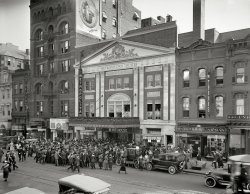
- Batista en Washington: 1938
- ... principles, attended Armistice Day ceremonies at Arlington National Cemetery, and wore a funny hat.
20 years to go In ... Posted by Dave - 08/23/2012 - 6:18pm -
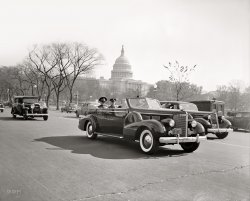
- Fancy Cakes: 1920
- Circa 1920. "Set pieces, Arlington Hotel." Including a polar pastry snowball iced with "Cook-Peary ... dating of this photo to 1920 may be in error. By 1920 The Arlington was no longer the Capitol's most opulent and trendy hotel. In 1912, ... other places to lay their heads when visiting D.C. and the Arlington would never again be the first-class establishment it had once been. ... Posted by Dave - 12/01/2014 - 10:54am -
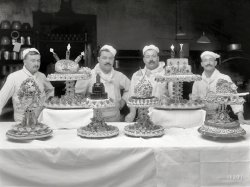
- American National: 1918
- ... died yesterday at his home, 2400 Fort Scott Drive, Arlington, Va. He was 64 years old.
Born here, Mr. Desio carried on the ... Posted by Dave - 08/23/2012 - 5:35pm -
![American National: 1918 Washington circa 1918. "American National Bank, F Street." Right next door to Harris & Ewing Photographers, who took so many of the photos (including this one) seen here on Shorpy. Harris & Ewing glass negative. View full size.
Still There?Please tell me this wonderful building is still there!
["This wonderful building is still there!" - Dave]
View Larger Map
Victor E. Desio & Co.
Desio & Co. will Remodel Dwelling
Victor E. Desio & Co. have plans prepared by Julius Wenig, architect, for remodeling the three-story and cellar store building at 1309 F street northwest. The entire building, which is 26 feet wide by 82 feet deep, will be remodeled into two stores. The front will be of all glass show windows, marble base and copper trimming. The second and third floors will be fitted out for store and work rooms, and an electric elevator will be installed from the first to third floor. Metal ceilings and marble floors will be a feature on the first floor.
When completed the work will represent an outlay of $8,000. Work will be started July 12, and Victor E. Desio & Co. will occupy the west store and Howard Deane the east store by September 1.
Washington Post, Jul 9, 1916
Victor E. Desio Rites Arranged Here Tomorrow
Victor E. Desio, retired jeweler, who for many years conducted business at 1309 F street Northwest, died yesterday at his home, 2400 Fort Scott Drive, Arlington, Va. He was 64 years old.
Born here, Mr. Desio carried on the jewelry business founded by his father, the late Gerome Desio, in 1874. He was a member of the Holy Name Society and the Lido Civic Club.
Washington Post, Jan 19, 1943
Not Entirely ThereThat wonderful steeple -- was this a cathedral of banking? -- is gone.
Motorized bicycleCheck out the motorized bicycle at the far right. The more recent Schwinn Heavy Duty or the Worksman bikes look like that.
Sidewalk sidecarCheck out the bike with the cargo sidecar in front of the bank! And what are those brass cans on the sidewalk?
[Fire extinguishers. - Dave]
Motor PlacementMotor is mounted on right front fork.
AKA Baltimore Sun Bldg.Originally built for the Baltimore Sun newspaper. Alternate Shorpy view in 1924.
Bank In Sun Building
American National Acquires F Street Structure
The American National Bank has bought the Baltimore Sun Building, the price it is understood, being between $210,000 and $225,000. The bank will remodel the interior of the building, and will take the entire two first floors for its bankroom, giving it one of the largest rooms, if not the largest in the city. The bank will move into its new building in September or October of the present year, the deed for the purchase of the big office building, one of the finest in the city, and one of the landmarks of F street, is consummated practically on the first birthday of the bank, its first year of existence having ended yesterday. The bank has been looking for a new location for some months, its present building on Fourteenth street not being large enough.
...
The building was the first of the "tall buildings" erected in Washington, and when it was built, about twenty years ago, it was the handsomest business buildings in the city. It cost for the actual construction about $340,000.
Washington Post, May 5, 1904
BicycleI see the bicycle, but having trouble locating the motor. Maybe he took it with him while he was shopping.
Motor BikeI'll be. It looks like a Smith Motor Wheel. They were usually mounted at the rear of the bike. I've never seen one up front. Just like the one that the lovey Ms. Young has on her Bug.
Dayton Motor BicycleThat's a very rare Dayton Motor Bicycle. The motor is indeed very similar to the Smith Motorwheel, but it was a version sold by the Davis Sewing Machine Company, makers of the Dayton brand at the time. The engine is in the middle of the front wheel. The patent is here.
(The Gallery, D.C., Harris + Ewing, Stores & Markets)](https://www.shorpy.com/files/images/13912a.thumbnail.jpg)























